Food Pantries On The Rise To Help 'Starving Students'

The expression “starving students” is not just a cliché. It’s real.
Researchers call this situation “food insecurity,” and it’s a concern that affects schools across the country, including many in the Pacific Northwest. A recent study in the Journal of Nutrition Education and Behavior found that 59 percent of students at Western Oregon University were going hungry.
In the past six years the number of food pantries in colleges in the U.S. has grown substantially. The Washington Post reports that food pantries have grown from 4 in 2008 to 121 in 2014.
These campus food banks are set up to help students who don’t have the means to eat. In Seattle, graduating seniors at the University of Washington are raising money to start an endowment to help financially struggling students to buy food.
Kailin Mooney is the operations manager of the University District Food Bank, which operates out of a church basement near UW on Northeast 50
Sponsored
th
Street. Mooney said these days she’s seeing more students come in. That doesn’t surprise her, given today’s cost of tuition and living expenses.
“When you’re in school that should be your main focus; you shouldn’t have to be worrying about where your next meal is going to come from and how you’re going to be paying your rent,” she said.
Mooney said students may be reluctant to go to food banks, but they offer healthier alternatives to instant noodles.
“We do offer healthy fruits and vegetables and whole grains and meat items. Top Ramen only gets you so far and it’s really not the best place to start when you’re needing to study and put your all into your school,” she said.
Sponsored
Mooney said in total more than 200 people come to the food bank on a given day, and they represent a wide range in life situations.
“We have a ton of working families,” Mooney said. “Single parents working two to three jobs to support one to four kids, and the only way they can make ends meet living here in the city is to use the food bank.”

